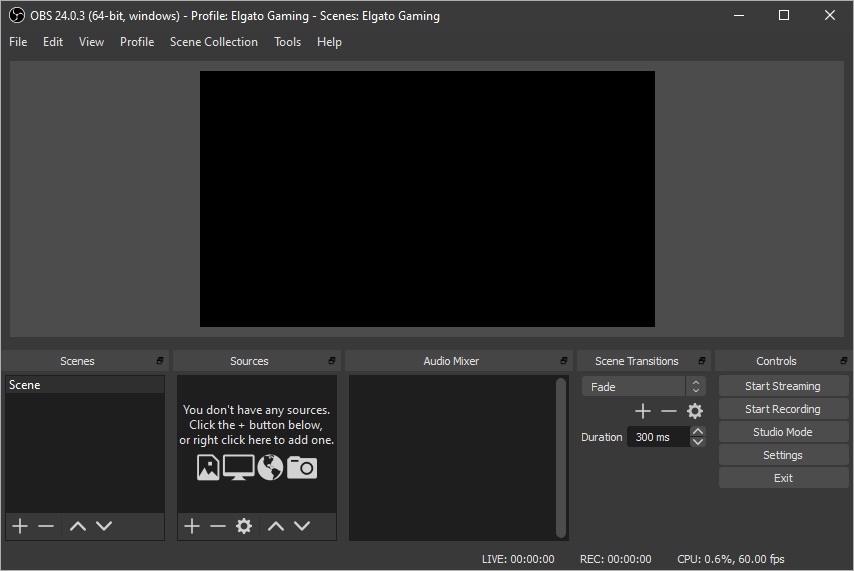

- #Obs studio written in how to#
- #Obs studio written in archive#
- #Obs studio written in download#
- #Obs studio written in windows#
Custom OBS Buildīy default, we download a pre-built version of libobs if none is specified.

#Obs studio written in archive#
This will will download any required dependencies, build the module, and then place it in an archive compatible with npm or yarn that you may specify in a given package.json. It follows a pretty standard cmake layout and you may execute it however you want.Ĭmake. We use a flexible cmake script to be as broad and generic as possible in order to prevent the need to constantly manage the cmake script for custom uses, while also providing sane defaults.
#Obs studio written in windows#
Windows SDK (may be installed with Visual Studio 2017 Installer).You will need to have the following installed:īuilding on windows requires additional software: Video and audio from Game Capture HD60 X are now being captured in OBS Studio.This library intends to provide bindings to obs-studio's internal library, named libobs accordingly, for the purpose of using it from a node runtime.Ĭurrently, only Windows and MacOS are supported. Ģ) Give the source a name such as Game Capture HD60 X Audio, and then click on OKģ) In the Device dropdown menu, select the Elgato Game Capture HD60 X, then click OK. Please note that these are not finalized numbers and may need to be adjusted.Ģ) In the Sources box, click on the ➕ icon and select Video Capture Deviceģ) Give the source a name such as Game Capture HD60 X, then click on OK.Ĥ) Select Elgato Game Capture HD60 X from the dropdown menu in the Device Properties Window.ġ) In the Sources box, click on the ➕ icon and select Audio Input Capture. To help get you started, are some recommended bitrates. This determines the overall recording quality. The Output tab allows you to adjust the Encoder, Video/Audio Bitrate, Recording Path, and more.Ģ) A new window will appear-select Output from the sidebar on the left-hand side.ģ) In the Output Mode dropdown, choose Advanced to switch from the Simple settings.ĥ) You'll now be able to adjust the Recording Path, Recording Format, Audio Tracks, Encoder, and Rescale Output.Ħ) Once the desired Recording Path and Format have been finalized, ensure the Encoder is set to Apple VT H264 Hardware Encoder.ħ) Bitrate is the number of bits per second. You'll now be able to adjust the Base (Canvas) Resolution, Output (Scaled) Resolution, Downscale Filter, and Frame Rate. The Base Canvas will determine what OBS displays, while the Output Resolution will change the recording resolution.ġ) Navigate to the bottom-right of OBS Studio and select Settings.Ģ) A new window will appear-select the Video tab. OBS Studio gives the ability to adjust the Frame Rate(FPS), Base Canvas, and Output Resolution.

If you're not happy with the desired results, hit Cancel to set the settings manually. Once the settings have been selected, click Next.ĥ) OBS Studio will attempt to determine the best settings for your Mac. We'll go with a Base Resolution of 1920x1080 and 60 FPS for this example. Select the Base (Canvas) Resolution and FPS. We'll go with Recording for this guide, but select the best option that applies to you and hit Next. ģ) The Auto-Configuration Wizard will appear. You can always modify the settings manually later.Ģ) Navigate to the Menu Bar and select Tools > Auto-Configuration Wizard. This includes streaming or recording, resolution, bitrate, encoder, streaming provider, etc. OBS Studio offers an Auto-Configuration, which automatically tests your system and attempts to find settings that your computer can handle. Apple M1 Chip or 4th generation quad‑core Intel Core i5 CPU (i5-4xxx or comparable).While this guide is written for OBS Studio, many steps are the same for Streamlabs Desktop.
#Obs studio written in how to#
This guide will show you how to use Elgato Game Capture HD60 X with OBS Studio.


 0 kommentar(er)
0 kommentar(er)
